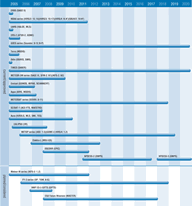Ozone
Ozone (O3) is a relatively unstable molecule, and although it represents only a tiny fraction of the atmosphere, ozone is crucial for life on Earth. Depending on its location ozone can protect or harm life on Earth. Most ozone resides in the stratosphere, where it acts as a shield to protect Earth's surface from the sun's harmful ultraviolet radiation. In the troposphere, ozone is a harmful pollutant which causes damage to lung tissue and plants. Man-made chemicals and weather conditions over Antarctica combine to deplete stratospheric ozone concentrations during the winter months there. The total amount of O3 in the troposphere is estimated to have increased by 36% since 1750, due primarily to anthropogenic emissions of several O3-forming gases.
Developments are under way to add ozone as a new NWP model variable, primarily to allow ozone observations to be used to act as a tracer for information on wind. More detail on ozone issues is presented in the case study in Part II of this document.
Satellite instruments have for many years provided data measuring interactions within the atmosphere that affect ozone, and soon more advanced instruments will be in orbit to collect more detailed measurements, increasing knowledge of how human activities are affecting Earth's protective ozone layer.
Total column measurements of ozone have been provided by NASA's TOMS and NOAA’s SBUV instruments over long periods. Stratospheric ozone profiles have also been measured by instruments such as HALOE & MLS (UARS mission), GOME (ERS-2), and SAGE III (part of the International Space Station payload).
Since launch in March 2002, GOMOS and SCIAMACHY on ESA's Envisat mission have provided improved observations of the concentration of ozone in the stratosphere and trace gases.
A wide range of instruments dedicated to, or capable of, ozone measurements are planned for the next decade. On the recently launched Aura mission, HIRDLS, OMI, and MLS study and monitor atmospheric processes which govern stratospheric and mesopheric ozone, and continue the TOMS record of total ozone measurements. TES on Aura is used to create three dimensional maps of ozone concentrations in the troposphere.
IASI and GOME-2 on the METOP series will provide information on both total column ozone and on vertical profile. The Ozone Profiler on China's FY-3 series will contribute further data continuously from 2006. In the longer term (from 2011), NOAA's Ozone Mapping and Profiler Suite (OMPS) will collect data to permit the calculation of the vertical and horizontal distribution of ozone in the atmosphere.
The IGOS theme on atmospheric chemistry observations (IGACO) has developed a strategy for the integrated provision of chemistry observations (and associated meteorological parameters) required to realise the theme objectives, including the monitoring of atmospheric composition parameters related to climate change.

